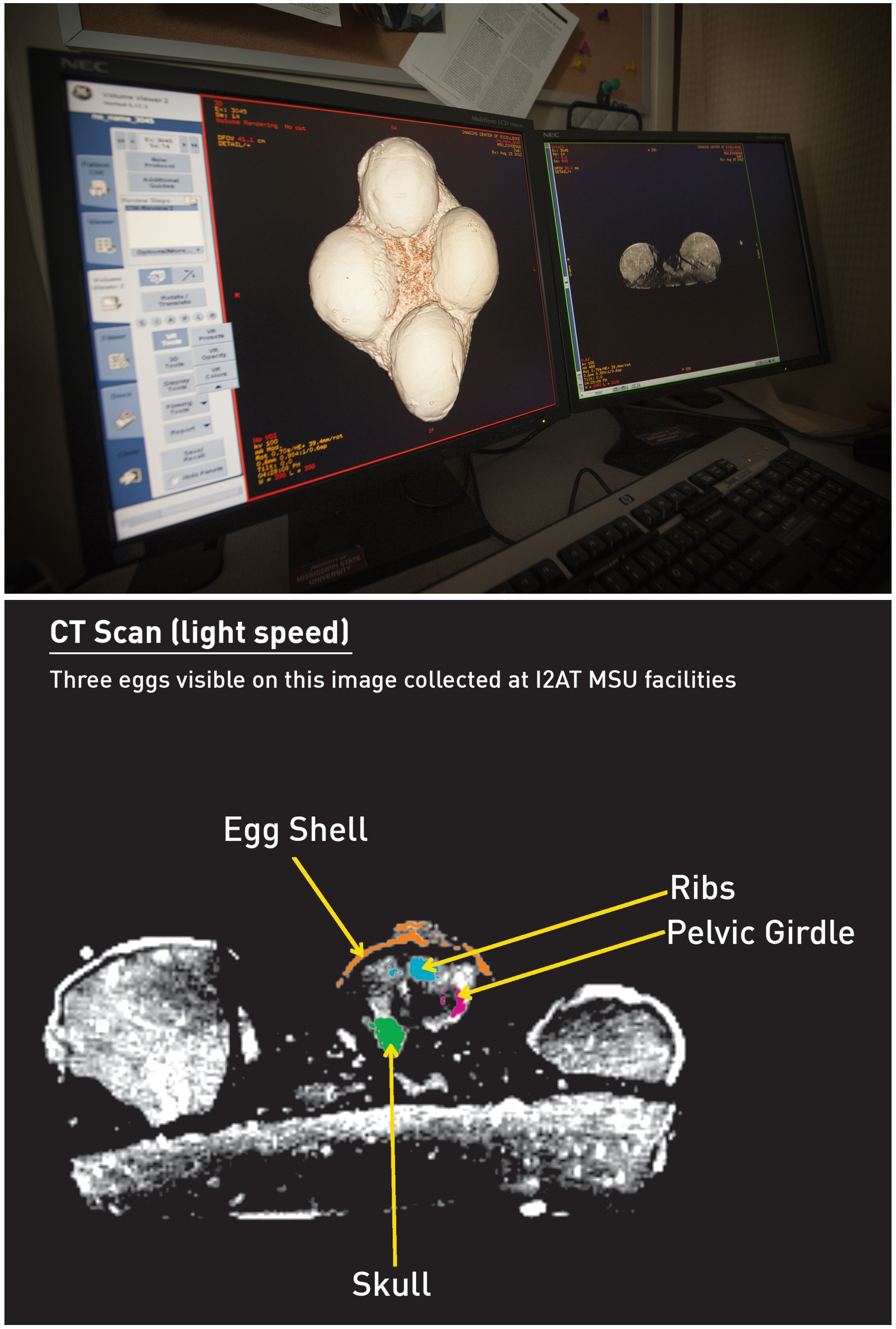Contact: Leah Barbour

Photo by: Megan Bean; Submitted image highlighted by Hayley Gilmore
STARKVILLE, Miss.--Fully intact dinosaur eggs never have been "virtually" dissected, but an international partnership stretching from Mississippi to Wales may change that this summer.
John Paul Jones of Mississippi State University is visiting the United Kingdom to use the extremely high-resolution 3D X-ray scanner in Oxfordshire as part of a collaboration with Amgueddfa Cymru--National Museum Wales.
The scanner may help the Starkville doctoral student in earth and atmospheric sciences answer his primary research question: What are the genus and species of the clutch of dinosaur eggs he found in Montana in 2002?
Jones is passionate about ensuring nothing and no one slices up the fossilized eggs that have survived intact for millions of years.
"If you cut it, then you have a damaged egg," he said. "It's just a rock that's been sliced in half. With the synchrotron technology, we'll get the actual image that can make a model.
"We're going to get a three-dimensional replica of the bones."
Jones said he hopes the synchrotron images, especially of the skull and pelvis, will have good detail because that should allow him to make definite identification of the dinosaur eggs.
He hypothesizes they may be the offspring of duck-billed dinosaurs called hadrosaurs, which feature hollow crests that may have been used to produce warning sounds or mating calls. Hadrosaurs were herbivorous creatures common during the Upper Cretaceous Period approximately 100 million years ago.
"I'm reluctant to say exactly what type of hadrosaur, but it looks like, from the lower resolution scans we already have, that there is a crest on the skull, which narrows it down to just a couple of species," Jones said. "If the imaging in the UK is good enough, we may even be able to tell what sex it was."
The Diamond Light Source in Oxfordshire applies synchrotron technology to create 3D images by producing X-ray tomographic images, or virtual "slices," of the eggs, said Christian Baars of Amgueddfa Cymru--National Museum Wales.
"X-rays travel through an object, and differences in the density within the object absorb parts of the X-rays more than others," Baars explained. "So, our equipment works a bit like an X-ray in the hospital when you have broken your arm. Bone is more dense than muscle, and, therefore, bone and muscle show up as different colors, or shades of grey, in the X-ray.
"The synchrotron works exactly the same; fossils often have a different density than the surrounding rock, and that difference shows up on an X-ray."
Rinat Gabitov, MSU assistant professor of geosciences, said the synchrotron-imaging technique is designed for extremely small structures--about one-10th the diameter of human hair. As a result, pinpointing the exact area of the clutch to scan is crucial, he said.
In 2012, Jones' MSU research team generated more than 10,000 scans when the dinosaur eggs were X-rayed by the LightSpeed VCT 64-Slice CT Scanner, Gabitov said. The equipment was made available through a partnership between MSU's Institute for Imaging and Analytical Technologies and Premier Imaging in Starkville.
"I had to adjust the contrast and the brightness of the models to really zone in on what I was seeing," Jones said. "One of the CT scans we did shows a definite and complete articulated embryo. The skull, pelvis, ribs, tail and perhaps legs are visible. I also found one egg was partially hollow. It has a disarticulated embryo in it, but you can still see some bones, but in the other two eggs, the resolution just wasn't high enough.
"It'll be the first time anyone's ever identified an embryo using the synchrotron method."
Jones, who completed his MSU master's degree in geology and geography in 2008, took the eggs he found in 2002, as well a second group of very similar ones he found in 2013 around the same Montana site.
As part of MSU's collaborative agreement, Jones will permit the Welsh museum to display the eggs after scanning is complete. Also, the Smithsonian Institution plans to feature a clutch in one of its Washington, D.C. displays.
"If I can, in fact, document that I've found a nesting site where dinosaurs came back and nested en masse, then that tells us more about the behavior of these animals," he said. "They may have done it for protection."
Travel grants from MSU's graduate school and the geosciences department are supporting Jones' trip, said Karen S. Coats, associate dean of the graduate school.
"This is a very unique and exciting project," she said. "John Paul will benefit greatly from collaborative research and represent Mississippi State University very well during his time abroad."
Prior to leaving for Wales, Jones and researchers at Auburn University's Auburn Noble Isotope Mass Analysis Laboratory tested ash crystals from the fossils to determine the eggs' age, according to geology professor Bill Hames at the Alabama institution.
"It is exciting to work with interesting paleontological samples and to provide precise estimates of their age," Hames said. "The reliability and usefulness of our result will depend on the quality of the sample, the precision of our equipment and our ability to account for all errors in measurement."
More information about MSU's earth and atmospheric sciences doctoral program is available at www.geosciences.msstate.edu.
Visit www.msstate.edu to learn more about MSU.